Conservatives hold 12-point lead over Labour heading into final week of the election campaign
- Corbyn has improved leader satisfaction ratings since October but still trails Johnson
- NHS is of increased importance to voters as an election issue
- One in four may change their minds on who to vote for before next Thursday
| Voting intention (changes from November) | |||||
|---|---|---|---|---|---|
| Conservative 44% (nc) | Labour 32% (+4) | Lib Dems 13% (-3) | Brexit Party 2% (-1) | Green 3% (nc) | Other 6% (nc) |
- Support for Labour is up 4 points from November. Support for the Lib Dems has fallen 3 points.
- Labour primarily drawing additional support from previous Labour voters in 2017, and also increasing support from 2017 Lib Dem voters compared with before the campaign.
- 72% have ‘definitely decided’ who to vote for. 27% may change their mind. This is more than the 20% that said they may change their mind at the equivalent time during the 2017 election.
- 80% of Conservative voters have ‘definitely decided’ to vote Conservative compared to 69% and 61% of Labour and Lib Dem voters respectively who have definitely decided to vote Labour or Lib Dem.
- Labour voters who may change their minds are most likely to say they will vote Lib Dem if they do (41%) and similarly Lib Dem voters who may change their minds are most likely to say they will vote Labour if they do (34%). This suggests that last minute switching between Labour and Lib Dem could be a key factor in the final election result.
Satisfaction with party leaders
- Boris Johnson’s net satisfaction rating as PM stands at -20 compared to Jeremy Corbyn’s net satisfaction rating as Labour leader of -44. One week before the 2017 General Election, Corbyn’s rating stood at -11 compared to May’s rating of -7.
- Boris Johnson’s ratings as PM have fallen after a rise in satisfaction in October, now back to where they were in September. 36% are satisfied with the job he is doing as PM (down 10 points from October), 56% are dissatisfied (up 12 points). However, Conservative supporters remain happy with him. 82% of Conservative voters are satisfied with the job Johnson is doing as PM. One week before the 2017 General Election, 43% were satisfied with May overall, including 82% of Conservative voters.
- Jeremy Corbyn’s satisfaction ratings have improved since October but they are still worse than where he started during the 2017 campaign. 24% are satisfied with the job the Labour leader is doing (up 9 pts from October) and 68% are dissatisfied (down 7 pts). His net rating of -44 compares to -11 at this stage of the 2017 General Election and a score of -41 at the beginning of that campaign.
- Satisfaction with Jo Swinson has fallen during the campaign. 29% are satisfied with the job she is doing as Lib Dem leader (no change from October) but 51% are dissatisfied (up 10 points). These numbers are comparable to Tim Farron’s figures ahead of the 2017 election where 25% were satisfied and 44% dissatisfied. For Swinson, 71% of Lib Dems are satisfied with the job she is doing (down from 80% in October) and Conservative voters have become more dissatisfied with her, up from 57% in October to 71% now.
- Nigel Farage’s ratings are relatively unchanged since October. 30% are satisfied with the job he is doing (up 1 point) and 56% are dissatisfied (up 5 points).
- Meanwhile satisfaction with how the government is running the country is low. 72% are dissatisfied with the way the government is running the country (down 2 points from October) compared to 53% that were dissatisfied with May’s government one week before the 2017 election.
Most capable PM
- Johnson retains a clear lead over Corbyn as the person the public see as the most capable Prime Minister. 47% consider Johnson the most capable Prime Minister compared to 31% for Jeremy Corbyn. This 16-point lead compares to a 19-point lead in November.
- One week before the 2017 election, May led Corbyn on this measure by 50% to 35%.
Election issues
- Brexit is still the number one issue of importance to voters – falling 13 points since November.
- The NHS has increased significantly as an issue for voters with 52% considering it an important issue (up from 41% in November). The NHS is just three points behind Brexit as the top issue on voters’ minds going into the election.
- Education is the third most important issue to voters (22%, up a point from November).
- Brexit and the NHS are the top two issues for each of Conservative, Labour and Liberal Democrat voters.
- There are clear gender differences in voter priorities. For men, 65% say Brexit is important and 44% say the NHS is important. For women, 60% say the NHS is important as an election issue and 45% say Brexit is important.
Best party on issues
- Looking at the two most important issues to voters, the Conservatives are seen as having the best policies on Britain’s future relationship with the EU ahead of Labour (by 38% to 20%), increasing their lead since July 2018 from 13 to 18 points but down on the 31 point lead they commanded in April 2017.
- On the other hand, Labour is seen as having the best policies on healthcare ahead of the Conservatives by 40% to 28%. This 12-point lead down from 18 points in July 2018 but similar to the 15-point lead held in April 2017.
- The Conservatives and Labour are neck and neck on who has the best policies on education (31% say Labour and 32% say Conservatives).
- In terms of other issues, the Conservatives lead Labour on managing the economy, asylum and immigration, crime, taxation and defence. The Conservatives lead over Labour on defence is the biggest lead they hold over the party on any issue (a lead of 33 points; 48% to 15%).
- Meanwhile, Labour lead the Conservatives as the best party on benefits, housing, pensions, poverty and inequality, care for older and disabled people and looking after the interests of working people. Labour also marginally leads the Lib Dems on looking after the interests of women. Labour’s biggest lead over the Conservatives on any issue relates to poverty and inequality, they lead the Conservatives by 24 points – 43% to 19%.
- Labour (16%) and the Conservatives (15%) are a long way behind the Green Party (34%) on who the public think is the best party on the environment.
Economic optimism
- Economic optimism remains weak with 50% expecting the economy to get worse in the next 12 months and 21% expecting it to improve. This creates an Economic Optimism Index of -29. However, there are some signs of progress in the past few months, with the proportion expecting the economy to get worse in the next 12 months falling from 59% in September to 56% in October and 50% now.
Gideon Skinner, Head of Politics at Ipsos, said:
People are making up their minds as the election comes closer, with Labour’s rise in large part due to them winning back more of their 2017 support, and squeezing the LibDems (for whom rising dissatisfaction with Jo Swinson among Conservative voters should also be a concern). The question is whether Labour are able to squeeze any more in the last week. There are some reasons for Labour to be hopeful, with Jeremy Corbyn’s ratings improving, dissatisfaction with the government’s record, the importance of the NHS rising and one in four voters saying they still may change their vote. But Mr Corbyn’s ratings are still very low – below where he started in 2017 – and there is little sign of any softening in the Conservative vote.
More of the British public are opposed to a second referendum on Scottish independence next year than support one
Four in ten (40%) of the British public think there should not be a second referendum on Scottish independence next year if the Scottish National Party wins most seats in Scotland in the general election on 12th December. Three in ten (31%) think there should be a second referendum next year, while a quarter (24%) say they have no feelings either way.
Conservative supporters are particularly against the idea of a second referendum next year (by 59% to 17%), Liberal Democrat supporters are in line with the average (44% think there should not be a referendum, while 33% think there should), while Labour voters are more in favour of a second independence referendum than not (by 44% to 22%).

Emily Gray, Managing Director of Ipsos Scotland, said:
Although public opinion on independence has shifted lately, with Scots split down the middle on how they’d vote in a second referendum, the timing of a second referendum remains a challenge for the SNP. While Nicola Sturgeon has said that a second independence referendum should happen next year, what we’re hearing from the public in both Scotland and Britain is that more of them don’t want a second independence referendum than want one. Labour voters across Britain are an exception though, with more saying there should be a second independence referendum next year than there shouldn’t – contrary to Jeremy Corbyn’s position that one would not take place in the first two years of a Labour administration.






